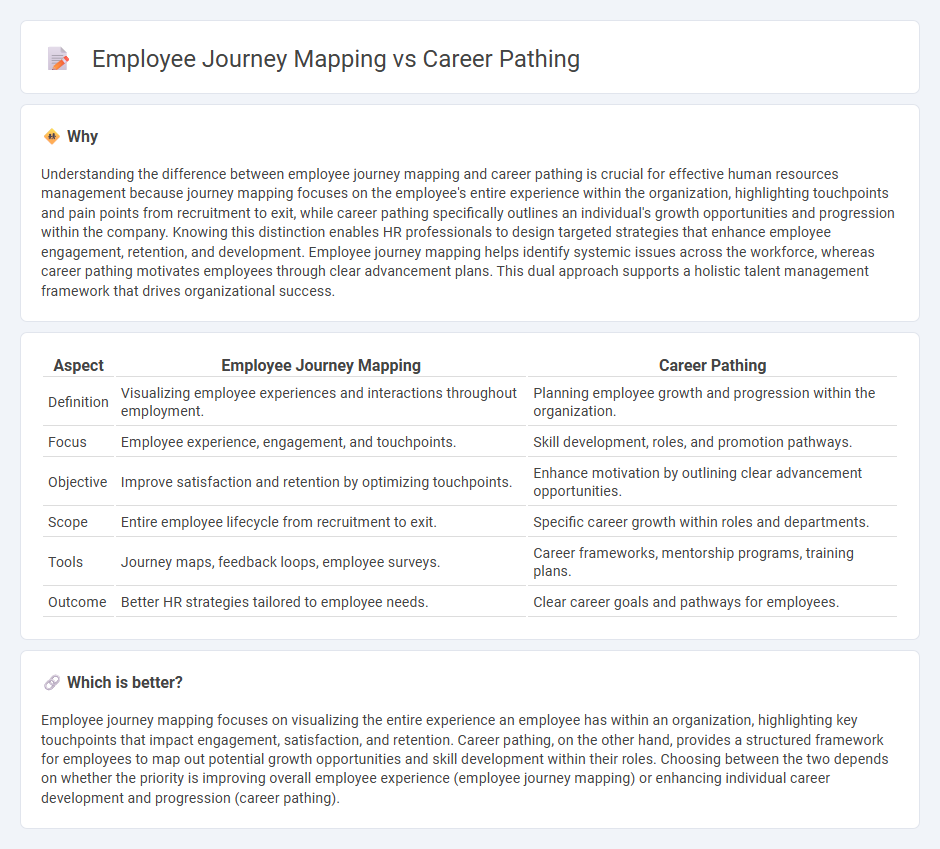
Employee journey mapping captures the entire experience an employee has within an organization, from recruitment through exit, focusing on touchpoints and emotional responses to improve engagement and retention. Career pathing emphasizes structured development trajectories and skill acquisition to guide employees toward specific roles and long-term growth within the company. Discover how integrating employee journey mapping with career pathing can optimize talent management strategies.
Why it is important
Understanding the difference between employee journey mapping and career pathing is crucial for effective human resources management because journey mapping focuses on the employee's entire experience within the organization, highlighting touchpoints and pain points from recruitment to exit, while career pathing specifically outlines an individual's growth opportunities and progression within the company. Knowing this distinction enables HR professionals to design targeted strategies that enhance employee engagement, retention, and development. Employee journey mapping helps identify systemic issues across the workforce, whereas career pathing motivates employees through clear advancement plans. This dual approach supports a holistic talent management framework that drives organizational success.
Comparison Table
| Aspect | Employee Journey Mapping | Career Pathing |
|---|---|---|
| Definition | Visualizing employee experiences and interactions throughout employment. | Planning employee growth and progression within the organization. |
| Focus | Employee experience, engagement, and touchpoints. | Skill development, roles, and promotion pathways. |
| Objective | Improve satisfaction and retention by optimizing touchpoints. | Enhance motivation by outlining clear advancement opportunities. |
| Scope | Entire employee lifecycle from recruitment to exit. | Specific career growth within roles and departments. |
| Tools | Journey maps, feedback loops, employee surveys. | Career frameworks, mentorship programs, training plans. |
| Outcome | Better HR strategies tailored to employee needs. | Clear career goals and pathways for employees. |
Which is better?
Employee journey mapping focuses on visualizing the entire experience an employee has within an organization, highlighting key touchpoints that impact engagement, satisfaction, and retention. Career pathing, on the other hand, provides a structured framework for employees to map out potential growth opportunities and skill development within their roles. Choosing between the two depends on whether the priority is improving overall employee experience (employee journey mapping) or enhancing individual career development and progression (career pathing).
Connection
Employee journey mapping identifies critical touchpoints and experiences throughout an employee's lifecycle, providing insights into engagement and development opportunities. Career pathing leverages this data to design tailored growth trajectories aligned with individual aspirations and organizational goals. Together, these strategies enhance talent retention by proactively addressing employee needs and fostering continuous professional development.
Key Terms
Career Pathing:
Career pathing is a strategic process that outlines an employee's progression within an organization by identifying potential roles, skill development opportunities, and growth milestones. It emphasizes long-term career development, aligning individual aspirations with company goals to enhance retention and motivation. Explore how career pathing can transform talent management and boost workforce engagement.
Skills Development
Career pathing emphasizes individual skills development by outlining clear progression routes and required competencies for advancement within an organization. Employee journey mapping charts the entire work experience, highlighting critical touchpoints where skill-building opportunities enhance engagement and performance. Explore how integrating these approaches can accelerate professional growth and organizational success.
Succession Planning
Career pathing centers on individual employee growth and skill development aimed at future roles within the company, forming a foundation for effective succession planning. Employee journey mapping tracks the complete employee experience from hiring to exit, identifying touchpoints that impact retention and talent readiness for key positions. Explore detailed strategies to integrate both tools seamlessly into your succession planning framework.
Source and External Links
What Is Career Pathing & Why Is It Important? - Paychex - Career pathing is employers' process for creating a development plan so employees can visualize how their skills and interests align with career goals, mapping potential roles and steps within or beyond the organization.
Career Pathing: The Complete Guide - Qualtrics - Career pathing uses tools like the career ladder (linear promotions) and career lattice (lateral/diverse moves) to help organizations and individuals plan growth, evaluate progress, and explore options.
Improve Employee Development with Career Pathing | Chronus - The career pathing process involves self-assessment, creating an individualized career map with a manager, and actively exploring internal opportunities for advancement or skill development.
 dowidth.com
dowidth.com